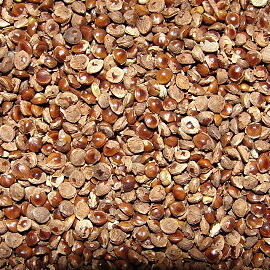Annual. Culms erect or decumbent, 20–60(–150) cm tall, nodes dark in color, glabrous. Leaves cauline; leaf sheaths loose, glabrous; leaf blades linear, flat, 8–40 × 0.4–0.8 cm, glabrous, base cordate to straight, apex acute or tapering; ligule ca. 1 mm, a ciliolate membrane. Panicle terminal, oblong or ovate in outline, 10–40 cm, densely branched and drooping or sparsely branched and erect; branches slender, scaberulous. Spikelets oblong in outline, 2.5–3.5 mm, glabrous; lower glume broadly ovate or cufflike, 1/4–1/3 length of spikelet, 3-veined, bluntly acute; upper glume as long as spikelet, 9–13-veined; lower lemma similar to upper glume, palea present or absent; upper floret brown or yellow, smooth, shiny. Fl. and fr. Jul–Oct. 2n = 54.
More
A millet grass. It can be erect or lie over. It is a grass which grows each year from seed. It can be 2 m tall. Plants which lie over can form roots at the nodes. The stem is strongly branched. There can be 46 erect flowering branches. Erect plants only produce 26 flowering shoots. The leaf blade is narrow and 56 cm long by 21 mm wide. The flowering heads can be open or compact. They are 50 cm long. They can have 14-52 branches. The spikelet is sword shaped and 2.5 mm long. The seed is shiny white to almost black.


